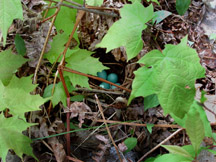Bird Nests
Birds build nests. In the nests, they lay their eggs and raise their nestlings.If you see an empty bird nest, you might not know which bird it belongs to but you have evidence that birds are in the area!
Birds construct a wide range of nests, from simple scrapes on the ground to elaborately woven nests of sticks and grasses. Some are camouflaged and some are out in the open. Some are big and some are small. It all depends on the bird, and where and how it lives!
Bird nests can be very large to very small, depending on the size of the bird. A blue heron is a large bird, so its nest can be as large as a coffee table. A hummingbird is a very small bird, so its nest can be as small as a doll-sized teacup.
Many shorebirds, such as killdeer, simply form a shallow depression on the ground and lay their eggs in it. This shallow depression is called a 'scrape.'
Some nests are loose arrangements of sticks. Some are more finely constructed nests of materials such as grass. They are often lined with softer materials like plant down, hair, downy feathers, or spider webs.
Some birds build their nests in more protected places, such as high in trees or in dense foliage. Other birds build their nests on the leaf-covered forest floor or just above the ground in low plants. For example, the ovenbird builds a nest shaped like a Dutch oven. It is built of dried grass, leaves, moss, other plant matter, and hair. The nest is well camouflaged with leaves, branches, and other litter placed on the roof. The entrance is a small slit on the side of the nest.
Many birds nest in cavities. The cavities are either constructed or natural. Birds such as woodpeckers carve their own nests in the trunks of mature trees. Other birds, such as black-capped chickadees, use cavities that they find.
Some nests are cemented to vertical surfaces, such as cliffs, buildings, or bridges. Swallows and swifts, such as barn swallows, make nests like this. They use mud, clay, grass, and saliva to create cup-like nests out of reach of predators.




